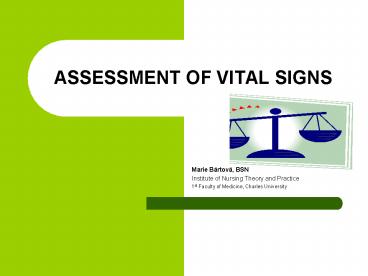ASSESSMENT OF VITAL SIGNS PowerPoint PPT Presentation
Title: ASSESSMENT OF VITAL SIGNS
1
ASSESSMENT OF VITAL SIGNS
- Marie Bártová, BSN
- Institute of Nursing Theory and Practice
- 1st Faculty of Medicine, Charles University
2
- www.lf1.cuni.cz
- ? Pracovište
- ? Ústav teorie a praxe ošetrovatelství
- ? 1st year medical students / 1st Aid
3
CONTENTS
- Consciousness
- Body temperature
- Respiration
- Blood pressure
- Pulse
4
1. CONSCIOUSNESS
- Human ability to be aware of own thoughts,
- emotions, surroundings ? adequate responses
- GLASGOW COMA SCALE (GCS)
- Patients response to
- - verbal stimulation
- - painful stimulation
- - movement
- Scale 3 15
5
CONSCIOUSNESS
Changes in consciousness Changes in consciousness
QUALITATIVE QUANTITATIVE
anxiety depression delirium somnolent sopor coma (shallow/deep)
6
2. BODY TEMPERATURE
- Balance between heat produced and heat lost by
the body - Heat regulating centre hypothalamus
- Heat production caused by increasing cell
metabolism - Heat losses (cool off process)
- - perspiration
- - respiration
- - radiation
- Types of thermometers
- - mercury-in-glass
- - electronic
- - chemical
7
BODY TEMPERATURE
BODY TEMPERATURE SYMPTOMS
Hypothermia ? 36 C Skin paleness Tiredness
Normal 36 36,9 C Lowest 5 6am Highest 4 6pm
Pyrexia / slight fever 37,0 37,9 C Perspiration Skin redness Headache
Fever ? 38 C Presence of infection ? body defence General weakness Tachycardia / hyperpnea Skin paleness/redness Shivers Perspiration
8
BODY TEMPERATURE
- ROUTES FOR MEASURING THE BODY TEMPERATURE
- - ORAL
- best site for measuring in the clinical
settings - triangle shaped thermometer
- axillo oral difference 0,3 C
- - AXILLARY
- more likely to be affected by the environmental
temperature, - used in children/adults
- - RECTAL
- fast thermometer, used in infants/confused
patients/receiving O2 th. - axillo rectal difference 0,5 C
- - VAGINAL
- used in gynecology
9
3. RESPIRATION
- NORMAL RESPIRATIONS
- Effortless
- Regular
- Smooth
- AVERAGE RESPIRATIONS
- Infant to 2 years 2434/min
- To puberty 20-26/min
- Adults 12-18/min
- RESPIRATORY RATE
- Normal 12 20 / min
- Bradypnea ? 10 / min
- Tachypnea ? 25 / min
- Apnea
- RESPIRATORY RHYTHM
- Normal
- Dyspnea (exertion/rest)
- Cheynes-Stokes respiration (irregular
deep/slow/shallow ) - Kussmauls breathing (deep)
10
4. BLOOD PRESSURE (BP)
- The pressure of blood in the arterial wall
- Factors affecting BP
- - blood volume
- - strength of contraction
- - elasticity of artery wall
- Assessment
- - Normal 120-140/60-80 mmHg
- - Hypertension ? 150/90 mmHg
- - Hypotension ?100 mmHg
- Measurements stated in terms of millimetres of
mercury (mmHg)
11
BLOOD PRESSURE (BP)
- BP reading
- - systolic pressure (ventricle contraction)
- - diastolic pressure (ventricle at rest)
- BP readings record BP 120/80
- Equipment
- - sphygmomanometer
- - stethoscope
12
BLOOD PRESSURE (BP)
- Places for measuring
- - upper arm (brachial artery)
- - calf / thigh (popliteal artery)
- Measuring techniques
- - auscultation
- (sphygmomanometerstethoscope) - palpation
- (sphygmomanometer)
- - invasive methods (CVP)
13
5. PULSE
- Expansion of an artery with each hart beat
- Measuring techniques / places of assessing
- - PALPATION
- a. carotis
- a. brachialis, radialis
- a. femoralis, poplitea etc.
- - AUSCULTATION
- stethoscope
14
PULSE
- PULSE RATE
- Normal 60 90 / min
- Bradycardia ? 50 / min
- Tachycardia ? 100 / min
- Asystolia
- PULSE RHYTHM
- Regular
- Irregular arrythmia
- PULSE QUALITY
- Strong (fever)
- Weak (shock/heart failure)
15
REPETITION
- What do you evaluate in Glasgow Coma Scale?
- What is the normal body temperature?
- Name 3 symptoms of fever.
- What is the most commonly used route for
measuring the body temperature in infant? - Could you define the term for the high
respiratory rate? - What is the limit for hypertension?
- Name 2 methods of BP measurement?
- Name 2 arteries where the pulse is most commonly
felt? - Could you specify the normal pulse rate?
- What is the point at which the beat stops during
the BP measurement called?
16
THANK YOU !

